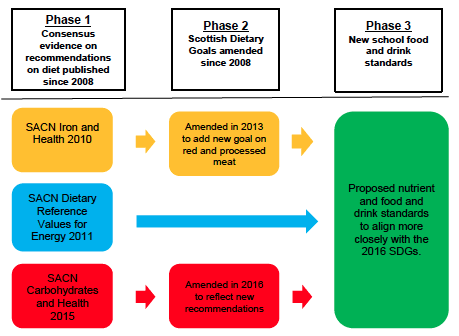Food and drink in schools: nutrition requirements review
Independent review by the Technical Working Group of nutrition requirements regulations.
3. Changes to Dietary Recommendations Since 2008
3.1 Background
The proposed standards have been developed to reflect the recommendations published by the Scientific Advisory Committee on Nutrition ( SACN) on Energy [4] , Carbohydrates and Health [5] and Iron and Health [6] . These recommendations are also reflected in the SDGs.
While other UK devolved nations and the Republic of Ireland have moved to solely food based standards for school lunches, it is proposed that in Scotland we should maintain and enforce nutrient standards, in addition to food standards. This will help to ensure that children and young people, especially those receiving free school meals, have access to nutritionally balanced school lunches that meet 30% of their nutritional requirements for the day.
It is proposed that the standards for primary and secondary schools are differentiated further, as the provision of school food within these two settings is vastly different. This will allow for the standards to be tailored, and thus more specific to each setting.
3.2 Nutrient Standards
Technical Considerations in Relation to Nutrition Standards
Energy
In 2011, SACN published new recommendations on energy reference values. The new energy reference values increased energy requirements for most population groups. This change reflects the more accurate methods used to assess energy expenditure. The new energy values have been used to calculate the proposed standards for energy in both primary and secondary. The resultant impact is a slight decrease in energy for the primary school lunch, and an increase in energy for the secondary school lunch.
Free sugars and fibre
In 2015 SACN published new recommendations relating to dietary carbohydrates 5. In 2016, the SDGs were amended to reflect the SACN recommendations, reducing the goal for free sugars to 5% of energy. The SDG for fibre was also changed in line with SACN recommendations.
Instead of setting the school lunch nutrient standard at 5%, in line with the SDG, a proposed new standard for school lunch has been set at 7.5%. This recognises the severity of moving to a 5% nutritional standard for free sugar in one step. Furthermore, there are insufficient standards for food and drink provided outwith lunch, and therefore high sugar options are currently available. It is for this reason that new standards for provision outwith lunch have been proposed. This will minimise disparities between lunch and outwith lunch and reduce sugar over the day.
Please refer to annexe 1 for definitions of non milk extrinsic sugars, free sugars and total sugars.
Protein
The proposed nutrient standard for protein is based on 15% of energy requirement. This is a change from the existing standard which is based on minimum protein requirement, calculated using average body weights [7] . Total fat and total carbohydrate standards are set at 35% and 50% of energy respectively, which leaves 15% of energy from protein, making a total of 100% energy from macronutrients. Although this appears to be a large increase, it is in line with amount of protein currently provided in school lunches.
3.3 Food and Drink Based Standards
Technical Considerations in relation to setting food and drink based standards
Red and Processed meat
In 2010, SACN published robust evidence linking red and processed meat to an increased risk of colorectal cancer in later life, and in 2013 Scottish Ministers agreed a new SDG limiting red and processed meat. More recently, in 2017, the World Cancer Research Fund [8] published updated evidence which strengthens the links between red and processed meat and risk of developing colorectal cancer, particularly with respect to processed meat.
To minimise the risk to the health of children and young people, new standards are proposed for red and red processed meat. Processed products made from poultry are not included within the proposed standards at this time as the strength of the evidence is weaker, however the exclusion of these products from the standard will be reviewed along with all other recommendations within 3 years to take account of any further scientific evidence published during this time.
Other Food Based Standards
A number of new proposed food based standards have been developed by the TWG to increase fibre, and limit the intake of fat, sugar and salt. New food based standards are therefore proposed for the following categories;
- Sweetened and baked products
- Breakfast cereals
- Sweetened yoghurts, fromage frais and other milk based desserts
- Pastry and pastry products
Furthermore the TWG propose amendments to the following standards;
- Fruits and vegetables
- Savoury snacks
- Bread
- Drinks
In addition a change in the definition of “confectionery” is proposed.
Please refer to annexe 2 for definition of confectionery.
3.4 Translation of Scientific Recommendations

Contact
There is a problem
Thanks for your feedback